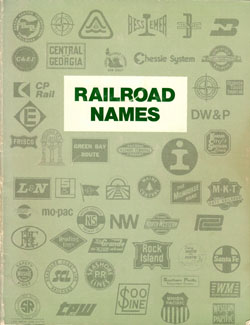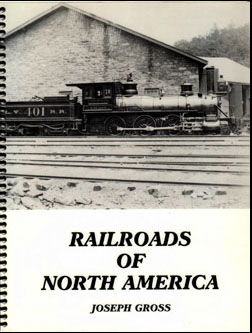Company numbering
The need for a numbering system
Prior to starting the project of listing railroad certificates, I had experience in several fields of collectibles, most of which had some form of numbering system. An early discussion with George LaBarre resulted in an estimate that I might ultimately find as many as 10,000 to 12,000 railroad certificates. At the time, we never estimated the number of railroad companies that might be involved, but had we done so, I probably would have used a guess of two or three certificates per company, which would have netted an estimate of about 3,000 to 6,000 companies.
Based on experiences in other hobbies, I firmly believed the project needed a numbering system. Whether the system would be used by dealers was a great unknown. However, I knew collectors well enough to know they hungered for shorthand systems of referring to their own collectibles, no matter whether they collected coins, stamps, currency, tokens or glass insulators.
 By their very nature, some collectibles already enjoyed a natural numbering system. Most coins, even coins from different countries. could be cataloged by denomination, date and mint mark. U.S. Currency could be catalogued in order of issuance and denomination. The same with stamps. Comics had titles and dates. Books had authors, titles and editions. All those collectibles had nuanced sub-varieties, but there were always sensible starting points.
By their very nature, some collectibles already enjoyed a natural numbering system. Most coins, even coins from different countries. could be cataloged by denomination, date and mint mark. U.S. Currency could be catalogued in order of issuance and denomination. The same with stamps. Comics had titles and dates. Books had authors, titles and editions. All those collectibles had nuanced sub-varieties, but there were always sensible starting points.
Several authors have used states of issuance as ways to group collectibles including:
- Grover Criswell, Confederate and Southern States Currency
- Grover Criswell, Confederate and Southern States Bonds
- Carlos Gaytan, Paper Currency of Mexico, 1822-1971
- James Haxby, United States Obsolete Bank Notes, 1782-1866
- Dean Oakes and John Hickman, Standard Catalog of National Bank Notes
While separating certificates on basis of origin appeared sensible, railroad certificates posed several problems:
- not all certificates display state of incorporation
- collectors would have needed foreknowledge of where companies incorporated
- companies frequently incorporated in states distant from where they operated
- companies often incorporated in multiple states
 Another alternative I considered was to create a numbering system based on railroad company initials: B&O, CB&Q, T&P, etc. That led me quickly into trouble when I estimated how many duplicated sets of initials there might be. Short names such as Sharon Railway would be troublesome as would companies that switched between "Railway" and "Railroad," not to mention companies that incorporated multiple times with exact same names.
Another alternative I considered was to create a numbering system based on railroad company initials: B&O, CB&Q, T&P, etc. That led me quickly into trouble when I estimated how many duplicated sets of initials there might be. Short names such as Sharon Railway would be troublesome as would companies that switched between "Railway" and "Railroad," not to mention companies that incorporated multiple times with exact same names.
As described on the main Companies page, I decided to form a numbering system based on railroad company names. My working assumption was that a pre-established list of companies would help decrease the number of surprises I knew would inevitably appear with new certificate discoveries.
The scheme
After much research and soul searching, I decided to construct a numbering system based on railroad company names using the first three letters of names with three arbitrary numbers in a manner like:
ABC-123
When new certificates appeared, even if companies had never been known before, collectors would always be able to find certificates by looking in the catalog exactly like a dictionary.
The start
The first step was to compile substantial list of company names. Fortunately, two major collections of railroad names already existed:
- William Edson, Railroad Names
- Joseph Gross, Railroads of North America
As expected, the sources contained many of the same names but at least I did not need to start from scratch. Gross held about 50% more names than Edson, but Edson contributed about 1,100 names that Gross had not acquired. As shown by the chart below, Edson and Gross both compiled some additional information:
| Data |
Edson |
Gross |
| Railroad name |
x |
x |
| Carrier class |
x |
|
| Marks (company abbreviations) |
|
x |
| Incorporation date |
x |
x |
| End date (bankruptcy, merger, etc.) |
x |
x |
| Mileage |
|
x |
| Predecessor company |
x |
|
| Disposition |
x |
x |
| Names included "RR" and "Ry" |
|
some |
Adding arbitrary numbers.
After transcribing names from Gross and Edson and removing, I set about adding another 2.000 names of companies that operated in Canada, Mexico, Central America and the Caribbean islands. I also added names of manufacturers of rolling stock, locomotives and infrastucture equipment such as signals and switches. With an initial spreadsheet collection of 13,000 to 14,000 names arrayed in alphabetical order, I began adding arbitrary numbers.
I next designed a spreadsheet routine that counted companies in all 3-letter groups and created equally-spaced three-digit numbers to attach to letters. When complete, I had catalog numbers that looked like:
- BAL-662 = Baltimore and Ohio
- CHI-085 = Chicago Burlington & Quincy
- TEX-571 = Texas & Pacific Eastern Division
Number modifications
"RR' and "Ry" versus "Railroad" and "Railway"
Once BNR Press published the first edition of my catalog (dated 1995 and released early in early 1996), I began a process of modifying listings. The first improvement needed was the addition of "Railroad" and "Railway" to company names. Gross had included "RR" and "Ry" abbreviations for about three-quarters of his names, but Edson had not included any.
Images of certificates in auction catalogs allowed me to expand names fairly easily. It became obvious during that process, however, that numerous companies had switched between Railroad and Railway monikers with surprising frequency and neither Edson or Gross had recorded their multiple names. Consequently, company numbers needed much fine-tuning to reflect multiple incorporations.
The importance of "The," hyphens and ampersands in names
it also dawned on me that almost no "authoritative" sources had cared to mention that the simple addition or removal of the word "The" that often – but not always – signaled changes in incorporations. I had to stay extra alert to changes in wording on certificates. Even hyphens and ampersands proved occasionally important.
Crowding
Equally obvious during that modification period was the conclusion that some company listings were becoming very crowded with new varieties. Each new addition was making it more difficult to identify varieties quickly.
For example, the listing for the Baltimore and Ohio Railroad had held 78 certificates when the first edition of my catalog reached collectors in 1996. All 78 were packed into the single "BAL-662" category. While the B&O operated under the same incorporation from 1827 until its merger into CSX in 1987, the company had actuallu used four different spellings of "Railroad" on its stocks and bonds. I knew the population of certificates was only going to grow, so I divided certificates into four groups based on spelling. Had I not made that separation in the late 1990s, the B&O listing would now contain 189 certificates,
The B&O and its several named corporate spinoffs are typical of modifications made elsewhere in the database for the purpose of improving usability of both the catalog and database. I guarantee, It was not what I initially had in mind. Here is how certificates of the B&O are numbered today:
- BAL-662a
- Baltimore & Ohio Rail Road Co
- BAL-662b
- Baltimore & Ohio Rail-Road Co
- BAL-662c
- The Baltimore & Ohio Rail Road Co
- BAL-662d
- The Baltimore & Ohio Railroad Co
- BAL-662e
- The Baltimore & Ohio Rail-Road Co Southwestern Division
- BAL-662f
- The Baltimore & Ohio Rail-Road Co Pittsburg Junction & Middle Division
- BAL-662g
- The Baltimore & Ohio Rail-Road Co Toledo-Cincinnati Division
- BAL-662h
- Baltimore & Ohio Rail-Road Co in Pennsylvania
- BAL-662i
- The Baltimore & Ohio Rail-Road Co (Dutch fund certificates)
- BAL-662t
- Baltimore & Ohio Rail-Road Trust
Whereas some numbering modifications have been based on factors such as dates and spellings, the majority are based on actual corporate changes,